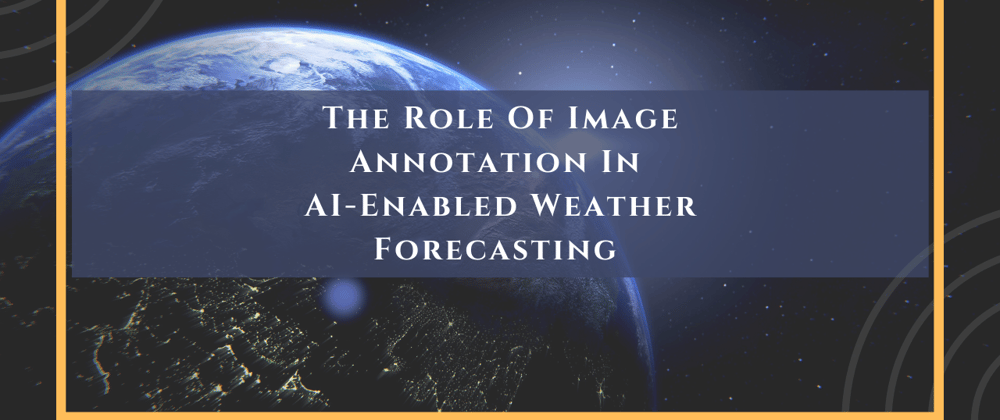Weather forecasts have always been an integral part of everyday life. Even decades back, every news item would be incomplete without a weather report. Today, weather forecasting is a much more complicated job. With rapid changes in the climate due to increased industrialization, people are relying on appropriate weather predictions to plan their day. However, up until recently, weather prediction was largely relying on supercomputers for processing large volumes of atmospheric data that were collected primarily from observatories located across the earth. These never ending files of data were then calculated using different concepts of physics like fluid dynamics, atmospheric pressure, etc. to make sense of it and give a correct prediction.
The traditional method of weather prediction was one that was marked with a cumbersome process of gathering information from different locations, which made the entire process lengthy, expensive, and prone to errors. However, with advances in technology, we now have smart methods of weather detection and prediction that are instant, accurate, real-time, and automated. Artificial intelligence with the assistance of image annotation can now identify and highlight even the tiniest weather changes by studying the weather patterns and phenomenon from previous years.
Let us know a little more about this.
How is AI helping make weather predictions?
One thing we know is that meteorological organizations have vast oceans of weather-related data from a significant time. Using data science and machine learning, these lots of information can be transformed into training data that fuels the AI to create certain models. These models demarcate every record by assigning different values to it. (Note: these values are a computer's way to differentiate one variable from the other.) With sufficient and accurate training data, AI systems can determine the weather correctly.
What are the benefits of using AI for weather forecasting?
In the present time, a large number of businesses depend on climatic conditions. It is no longer restricted to finding out whether this year we will have good agricultural produce or not. From clean energy to missile testing, satellite launching to saving populations from extreme weather conditions, modern time is highly dependent on correct weather forecasts. With the use of AI, everyone across society is benefiting in several ways. Some of the ways how the use of new technology solutions have transformed weather forecasting are:
● AI algorithms can predict shorter weather changes to larger climatic implications over a significant period of time. This gives policy makers and the human society at large, to undertake necessary actions in order to avoid any catastrophic eventuality.
● Machine learning has made complex functions like studying cloud patterns easier and more accurate. With this, the prediction of hurricanes and tornadoes have become appropriate to help averse disasters and save human life and property.
● AI technology can be modified to study the physical aspects of the environment of a given geographical area. This way, users can study and analyze how a particular weather phenomenon can impact their location.
● Real-time prediction is another great advantage of AI and machine learning in weather forecasting, something that was impossible during the days of manual calculations. The sophisticated algorithms can study little changes and display them in a visual manner within seconds of detection. Thus helping offer information in real-time as and when they happen.
● The entry of AI into the realm of weather forecasting has also made the entire process more cost-efficient, highly predictable, and accurate.
How AI and machine learning forecasts the weather?
Do you remember that we discussed above the importance of datasets that train AI to make predictions? Well, images are a crucial part of these datasets. After all, in order for machines to identify cloud patterns and atmospheric conditions, they should have the access to correct sets of visual images that will help them link them to a particular climatic phenomenon or weather condition. Without images, machines, no matter how sophisticated they are, will not be able to make any sense of what they are looking at and how to analyze them.
Image annotation means annotating certain images with the right text, labels, and even context so that machines can pick them up, link them to certain inputs and offer analysis.
So, you can understand that without image annotation services, AI and machine learning will not be able to offer much help. To make AI even smarter and accurate, it is important to feed them with highly refined sets of annotated images.
Image annotation will help the satellite make the right predictive analysis which will raise alarms in the case of a coming calamity. However, it is an ongoing process, one that demands skill and an experienced eye. Image annotation requires experts who understands the nuances of every image and tags them accordingly. Organizations that deal with weather forecasting often opt to outsource image annotation services as it is a demanding job and it is difficult to find experienced annotators.
Other than image annotation, weather forecasting AI also requires other forms of data labeling. Labeled data reduces the chances of errors and so, at times such jobs also require manual data labeling or manual overviewing of the data labeling process. Automated data labeling greatly helps in easing out the process of data annotation.
Automated data annotation not only boosts productivity and efficiency, they are also extremely cost-efficient. It also allows users to upgrade annotation software instantly and switch between applications to get the best out of the datasets. Automated annotation also helps in identifying which aspects of the datasets require further labeling and refining.
Machine learning in meteorology brings together the best of human knowledge and computer power. This new advancement has revolutionized weather prediction practices making it apt and precise. It is indeed an exciting junction and the coming together of machine and humankind continues to reveal newer innovations in this field. It is only a matter of time that we will be able to enjoy hyperlocal weather predictions that will be aligned with our calendars and even our personal health status.







Top comments (0)